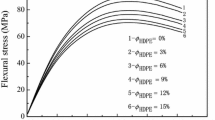Abstract
A 100-h-long cavitation erosion experiment was performed on a sample of polytetrafluoroethelyene (PTFE). The weight loss curve of PTFE was different from that of metals, and the erosion process was characterized by two stages, each with a distinct erosion rate. Morphology studies on the erosion pits and X-ray diffraction analysis of the eroded surfaces revealed that brittle fracture was the main reason for the higher erosion rate at the beginning of the erosion process, while ductile fracture dominated the weight loss process later in the erosion process, thereby reducing the erosion rate. Based on these results, we consider that this transition from brittle to ductile fracture was responsible for the different erosion rates at the two different erosion stages.





Similar content being viewed by others
References
Wood, R.J.K.: Erosion-corrosion interactions and their effect on marine and offshore materials. Review. Wear 261, 1012–1023 (2006)
Stack, M.M., Jana, B.D.: Modelling particulate erosion–corrosion in aqueous slurries: some views on the construction of erosion–corrosion maps for a range of pure metals. Wear 256, 986–1004 (2004)
Knapp, R.T., Daily, J.W., Hammit, F.G.: Cavitation. McGraw-Hill, New York (1970)
Karimi, A., Schmid, R.K.: Ripple formation in solid–liquid erosion. Wear 156, 33–47 (1992)
Chen, H.S., Li, Y.J., Chen, D.R., Wang, J.D.: Experimental and numerical investigations on development of cavitation erosion pits on solid surface. Tribol. Lett. 26, 153–159 (2007)
Chen, H.S., Liu, S., Wang, J., Chen, D.: Spherical dendritic particles formed in cavitation erosion. Mater. Lett. 62, 2707–2709 (2008)
Kwok, C.T., Man, H.C., Cheng, F.T.: Synergistic effect of cavitation erosion and corrosion of various engineering alloys in 3.5% NaCl solution. Mater. Sci. Eng. A 290, 145–154 (2000)
Franta, I.: Elastomers and rubber compounding materials, studies in polymer science, p. 294. Elsevier Science, New York (1989)
Blackley, D.C.: Synthetic rubbers: their chemistry and technology, pp. 283–287. Applied Science, London (1983)
Pruitt, L.A.: Deformation, yielding, fracture and fatigue behavior of conventional and highly cross-linked ultra high molecular weight polyethylene. Biomaterials 26, 905 (2005)
Clark, E.S.: The molecular conformations of polytetrafluoroethylene: forms II and IV. Polymer 40, 4659 (1999)
Sperati, C.A., Starkweather Jr, H.W.: Fluorine-containing polymers. II. Polytetrafluoroethylene. Advances in polymer science. 2, pp. 465–495. Springer, Berlin (1961)
Acknowledgments
This work is supported by NSFC Projects (No. 50805008 and 50975158). Also, the authors would like to thank Yang Wenyan and Bing Dong (Tsinghua University) for their contributions to this experiment.
Author information
Authors and Affiliations
Corresponding author
Rights and permissions
About this article
Cite this article
Liu, C., Li, J. & Chen, H. Cavitation Erosion on Solid Polymers of Polytetrafluoroethelyene. Tribol Lett 47, 17–20 (2012). https://doi.org/10.1007/s11249-012-9953-4
Received:
Accepted:
Published:
Issue Date:
DOI: https://doi.org/10.1007/s11249-012-9953-4




